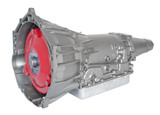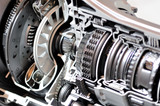8 Basic Automatic Transmission Maintenance Tips
Transmission maintenance is important because it can help prevent future car problems, extend the life of your transmission, and improve your vehicle's overall performance.
But wait, that's not all! Transmission maintenance can help you avoid costly repairs, and you'll be saving a lot of money long-term! Now, who doesn't love saving money? We sure do!
Transmission Maintenance Tips You Need to Know
To keep your car happy and your wallet full, here are eight basic transmission maintenance tips.
1. Allow Your Engine to Warm Up
First, always let your engine warm-up for a few minutes before driving off.
If you don't, your car will be running on cold transmission fluid, and the transmission itself will have to work harder to do its job. It's not good for your transmission to be placed under this type of stress, especially during the winter months when it's freezing outside.
You should also avoid accelerating too fast or too hard until the transmission has had a chance to properly warm itself up. The time it takes a transmission to warm up can be anywhere between 5 to 20 minutes. However, if you have a newer car, your engine may only need a mere 30 seconds.
2. Be Wary of Driving on Spares or Mismatched Tires
Avoid driving on a spare, small, or mismatched tire for a long period of time. Driving under these conditions can cause premature wear on the transmission and jeopardize the safety of yourself and other passengers sharing the road.
If you have a flat tire, it's crucial to replace it as soon as possible. However, sometimes this isn't always possible right away for many reasons (e.g., cannot afford to or the local tire shop is closed). If you can't replace the flat tire right away, allow your car to sit in a safe place until you can get a permanent tire.
3. Annual Transmission Inspections
As part of your transmission maintenance, it's wise to have your transmission inspected by a professional mechanic for leaks, creaks, and other potential ongoing issues on an annual basis (one year). This will help to ensure that your transmission lasts for as long as possible.
Additionally, be sure to regularly check your transmission fluid level and top it off if necessary!
Remember: If you notice any strange noises or behaviors, don't hesitate to get it checked out - it'll save you a lot of money, worry, and stress down the road (no pun intended)!
4. Perform a Transmission Flush
As one of the most critical parts of a car, your transmission needs to be taken care of in order to keep your vehicle running smoothly. One way to take care of your transmission is to get it flushed regularly, which would be approximately once every year. More than likely, this type of transmission maintenance will be included as a part of a transmission inspection service.
A transmission flush is performed by flushing out the old fluid and replacing it with new fluid. This helps to keep the transmission clean and running smoothly. It also helps to prevent transmission problems later on.
If you're not sure whether or not your transmission needs to be flushed, it's always best to consult with a professional mechanic. A mechanic will be able to take a look at your car and let you know if a flush is required.
Furthermore, you can also read through your owner's manual to know the recommended time for a transmission flush specific to your vehicle.
5. Picking the Right Transmission Fluid
Be sure to choose the correct transmission fluid for your vehicle. Placing the wrong type of fluid in your car can cause significant damage to the transmission, such as overheating, which can cause transmission failure. Again, it's always best to read your owner's manual or talk to a professional mechanic to ensure you're using the right type.
There are several different types of transmission fluids, each designed for specific types of transmissions. For example, there are fluids specifically for automatic transmissions, as well as fluids for manual transmissions.
Once you've chosen the correct type of transmission fluid, it's important to also select the right brand. Not all brands are the same, and some may be better suited for your car than others.
6. Regular Transmission Fluid Checks
A car transmission is a complex system made up of many different parts, and transmission fluid is essential to its proper function. Over time, transmission fluid eventually breaks down and becomes contaminated, which can lead to problems. That's why it's always important to regularly check your transmission fluid and change it as needed.
When checking the transmission fluid, there are several things to keep in mind:
- Low Fluid: Indicates a possible leak.
- Dark Fluid: Not normal; transmission fluid should be bright red.
7. Change the Transmission Filter
If your car has a transmission filter, get in the habit of changing it on a regular basis because it will help keep your transmission healthy. A lot of people forget about this filter, but it's actually an essential part of your car's transmission maintenance.
The process of changing your transmission filter may vary depending on your car. Generally, it's recommended that a filter be changed out every 30,000 miles or 30 months.
8. Service the Cooling System
If your engine's cooling system isn't functioning correctly, it could create other issues for your transmission in time.
For example, if the coolant level gets too low, it can cause the engine to overheat. This can cause serious damage, including warping the cylinder head and damaging the transmission itself. In extreme cases or a worst-case scenario, it can even lead to a fire.
Practice Routine Transmission Maintenance Today
Transmission maintenance, such as getting the cooling system serviced or getting routine checks to identify potential leaks, is essential because it helps to ensure that your car's transmission is working correctly and as intended. By keeping the transmission in good condition, you can avoid costly repairs and extend the life of your vehicle.
While typically performed by a qualified mechanic, you can also do some simple maintenance tasks at home to help keep your transmission in top condition for many years!
For more information, check out our news section for weekly posts on transmissions, converters and controllers, tips, and more.
Gearstar takes pride in building custom automatic transmissions from start to finish by a single builder. If you want more resources, visit our support page for a list of FAQs to get you started for installations, instructions, and all things transmission. Still have questions? Reach out to us anytime, and we will be glad to assist you.




